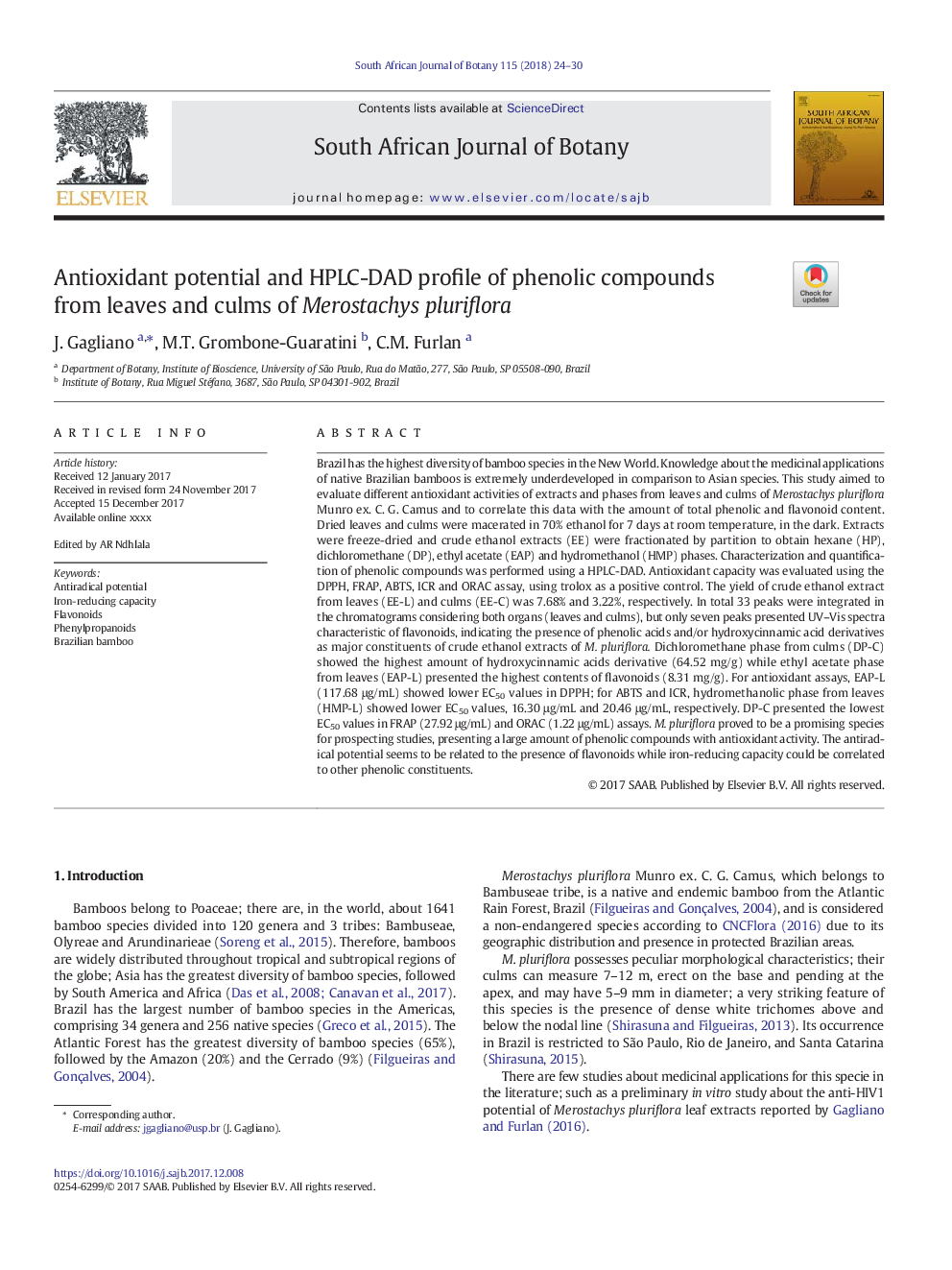| کد مقاله | کد نشریه | سال انتشار | مقاله انگلیسی | نسخه تمام متن |
|---|---|---|---|---|
| 8882324 | 1625143 | 2018 | 7 صفحه PDF | دانلود رایگان |
عنوان انگلیسی مقاله ISI
Antioxidant potential and HPLC-DAD profile of phenolic compounds from leaves and culms of Merostachys pluriflora
دانلود مقاله + سفارش ترجمه
دانلود مقاله ISI انگلیسی
رایگان برای ایرانیان
موضوعات مرتبط
علوم زیستی و بیوفناوری
علوم کشاورزی و بیولوژیک
علوم زراعت و اصلاح نباتات
پیش نمایش صفحه اول مقاله

چکیده انگلیسی
Brazil has the highest diversity of bamboo species in the New World. Knowledge about the medicinal applications of native Brazilian bamboos is extremely underdeveloped in comparison to Asian species. This study aimed to evaluate different antioxidant activities of extracts and phases from leaves and culms of Merostachys pluriflora Munro ex. C. G. Camus and to correlate this data with the amount of total phenolic and flavonoid content. Dried leaves and culms were macerated in 70% ethanol for 7 days at room temperature, in the dark. Extracts were freeze-dried and crude ethanol extracts (EE) were fractionated by partition to obtain hexane (HP), dichloromethane (DP), ethyl acetate (EAP) and hydromethanol (HMP) phases. Characterization and quantification of phenolic compounds was performed using a HPLC-DAD. Antioxidant capacity was evaluated using the DPPH, FRAP, ABTS, ICR and ORAC assay, using trolox as a positive control. The yield of crude ethanol extract from leaves (EE-L) and culms (EE-C) was 7.68% and 3.22%, respectively. In total 33 peaks were integrated in the chromatograms considering both organs (leaves and culms), but only seven peaks presented UV-Vis spectra characteristic of flavonoids, indicating the presence of phenolic acids and/or hydroxycinnamic acid derivatives as major constituents of crude ethanol extracts of M. pluriflora. Dichloromethane phase from culms (DP-C) showed the highest amount of hydroxycinnamic acids derivative (64.52 mg/g) while ethyl acetate phase from leaves (EAP-L) presented the highest contents of flavonoids (8.31 mg/g). For antioxidant assays, EAP-L (117.68 μg/mL) showed lower EC50 values in DPPH; for ABTS and ICR, hydromethanolic phase from leaves (HMP-L) showed lower EC50 values, 16.30 μg/mL and 20.46 μg/mL, respectively. DP-C presented the lowest EC50 values in FRAP (27.92 μg/mL) and ORAC (1.22 μg/mL) assays. M. pluriflora proved to be a promising species for prospecting studies, presenting a large amount of phenolic compounds with antioxidant activity. The antiradical potential seems to be related to the presence of flavonoids while iron-reducing capacity could be correlated to other phenolic constituents.
ناشر
Database: Elsevier - ScienceDirect (ساینس دایرکت)
Journal: South African Journal of Botany - Volume 115, March 2018, Pages 24-30
Journal: South African Journal of Botany - Volume 115, March 2018, Pages 24-30
نویسندگان
J. Gagliano, M.T. Grombone-Guaratini, C.M. Furlan,